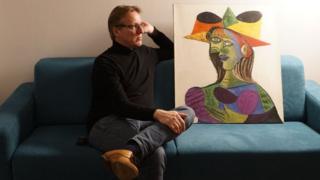Art detective finds stolen Picasso after 20 years
A Dutchman known as the “Indiana Jones of the art world” has found a Picasso painting that was stolen 20 years ago.
Arthur Brand says the portrait was circulated in the Dutch criminal underworld for years after it was taken from a Saudi sheikh’s yacht in 1999.
Buste de Femme (Dora Maar) was first painted in 1938, and is now thought to be worth €25m (£21m; $28m).
Dora Maar was Pablo Picasso’s lover and muse for seven years. The painting hung in his home until his death in 1973.
Mr Brand hit headlines last year after tracking down a Byzantine mosaic of Saint Mark. It had been taken from a church in Cyprus in the 1970s.
He also won international acclaim in 2015 when he found Hitler’s Horses – two bronze statues by Nazi sculptor Joseph Thorak.
The Picasso painting, he told news agency AFP, was circulated for years, “often being used as collateral, popping up in a drug deal here, four years later in an arms deal there”.
“Everyone assumed it had been destroyed – that’s what happens with 90% of all stolen art, because it can’t be put on sale,” he told Dutch newspaper De Volkskrant, adding that after he recovered the painting, he hung it on his wall for the night “and thoroughly enjoyed it”.
How did he find it?
Mr Brand’s search for the stolen portrait began in 2015 after he heard that a “Picasso stolen from a ship” was being circulated among criminals in the Netherlands, although he did not know exactly which work it was.
After several years of searching, Mr Brand worked out that the painting was Buste de Femme (Dora Maar) – also known as Portrait of Dora Maar.
Dora Maar, who was born Theodora Markovitch in 1907, was a renowned photographer and artist in her own right. She was in a relationship with Picasso from 1936 to 1943. She died in 1997 at the age of 89.
The painting had been stolen from Coral Island, a luxury yacht belonging to Saudi billionaire Sheikh Abdul Mohsen Abdulmalik Al-Sheikh, while it was anchored in Antibes for refurbishment.
Once he knew exactly which artwork he was looking for, he was able to put out appeals to people who may have inadvertently bought it. Earlier this month, he got a response.
“Two representatives of a Dutch businessman contacted me, saying their client had the painting. He was at his wits’ end,” he told AFP. “He thought the Picasso was part of a legitimate deal. It turns out the deal was legitimate – the method of payment was not.”
They then brought the masterpiece to his flat in Amsterdam, wrapped in a sheet and some black rubbish bags.
Police in France and the Netherlands have said that they will not prosecute the painting’s last owner. It is now being held by an insurance company, which will decide what to do next.
Source: Read Full Article



